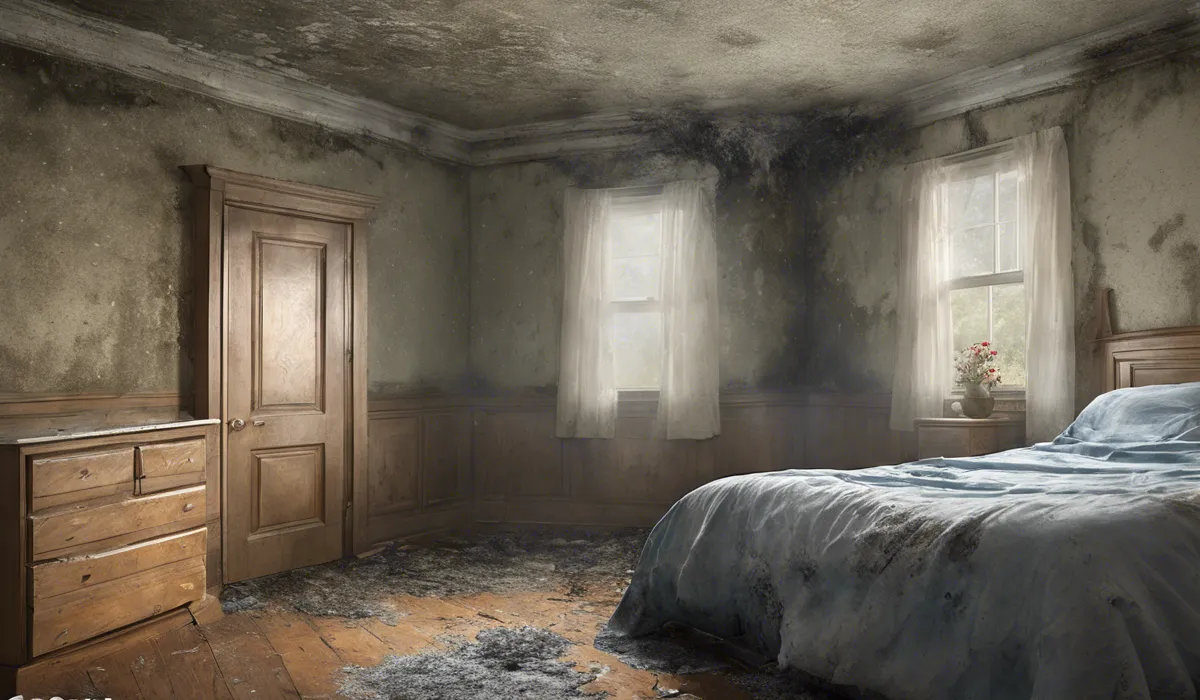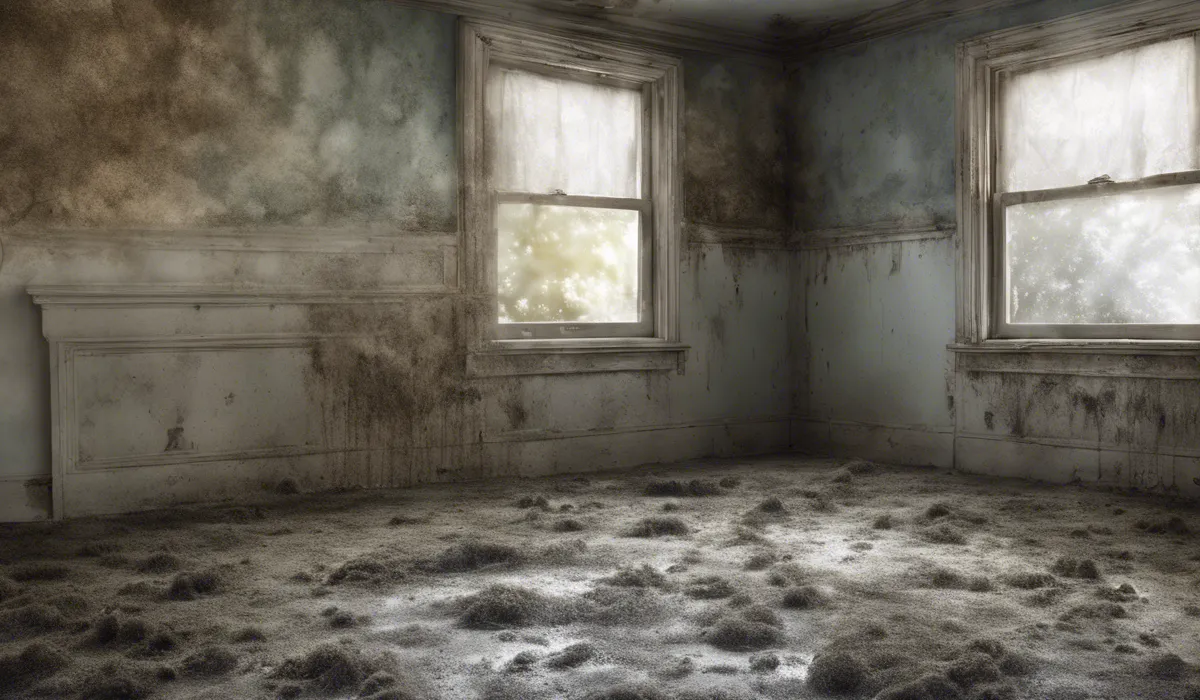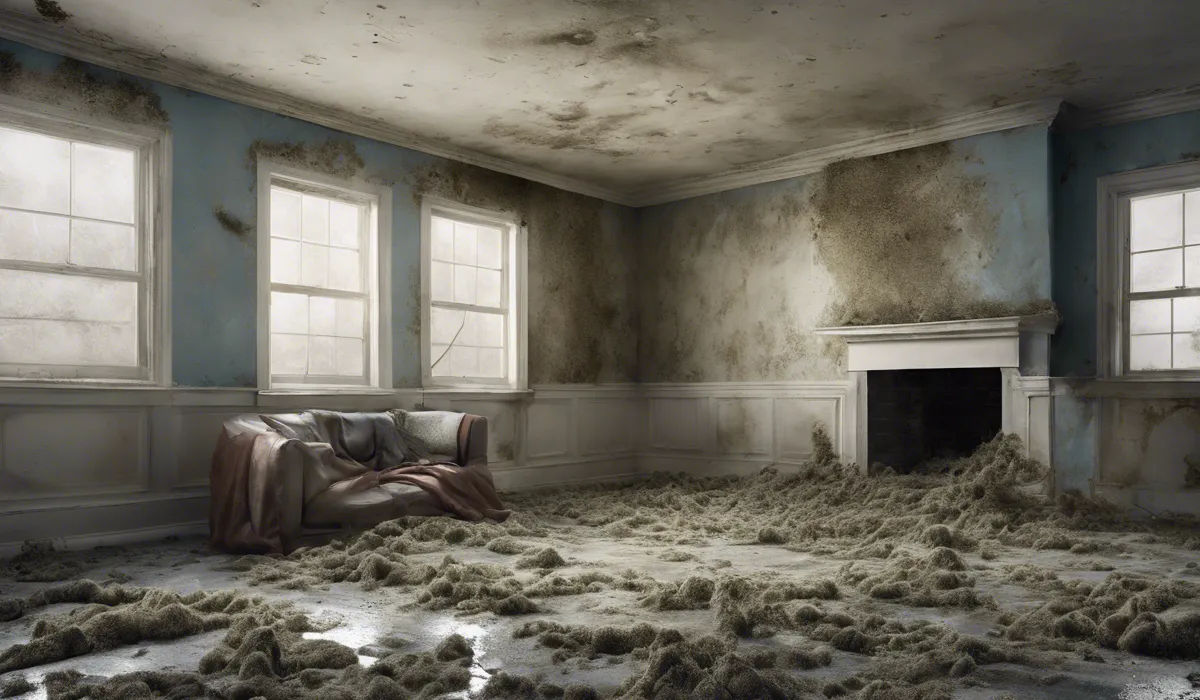Mold in a house typically appears as irregularly shaped spots or patches. Colors range from black, green, white to yellow. It often has a fuzzy or slimy texture and may be found in damp areas such as bathrooms, basements, or around leaks.
Identification of Mold

Description of Common Mold Textures
When mold makes its unwelcome appearance in a house, it can take on various textures that signal its presence. One might find mold with a fuzzy appearance, similar to the outside of a peach.
This texture often indicates a colony that is thriving and actively growing. On the other hand, a slimy texture can be a sign of mold in very wet environments, and this type of mold can be slippery to touch.
Yet another texture mold can present is leathery, which is typically drier and may be found in areas with less moisture but high humidity.
Color Variations of Mold
Mold is not just one color. It can be a rainbow of danger in your home. Black mold, known for being particularly nefarious, can be a sign of a serious issue. But mold also comes in white, which can look like a thin, thread-like webbing.
Green mold is fairly common and might look similar to the moss you would find in nature. Yellow and blue molds add an unexpected splash of color but are no less troublesome.
Red mold is less common but can be found in homes, adding to the spectrum of mold colors one might encounter.
Typical Locations Where Mold is Found in the Home
Moisture is mold’s best friend, and this means certain areas in your home are hotspots for mold growth. Bathrooms, with their running water and steam, are prime real estate for mold colonies.
Kitchens are also susceptible, particularly under sinks or around leaky appliances. Basements, with their tendency to be damp and poorly ventilated, are ideal for mold to thrive.
Windows, especially those with condensation issues, can provide mold with the moisture it needs.
Finally, under carpets, an often-overlooked area, can harbor mold if moisture has been trapped underneath.
Signs of Hidden Mold
Sometimes mold is not immediately visible, but there are clues to its presence. A musty odor is a telltale sign, indicating mold may be lurking out of sight.
Water stains on ceilings or walls can also suggest mold growth. If paint or wallpaper is peeling, bubbling, or cracking, it might be due to mold breaking down the material behind it.
These signs should not be ignored as they can indicate a larger problem hidden from view.
Health Implications of Mold Exposure

Short-term Health Effects
Exposure to mold can lead to various short-term health issues. Allergic reactions are common and can include sneezing, runny or blocked nose, and itchy eyes.
Some people may experience throat irritation or coughing, while others might have skin irritation upon contact with mold.
These symptoms are your body’s immediate response to the unwelcome intruders.
Long-term Health Effects
Long-term exposure to mold can have more serious consequences. Respiratory issues can develop over time, and people with asthma might find their condition worsening.
Mold exposure can also suppress the immune system, making it harder for the body to fend off other illnesses. It’s crucial to tackle mold problems early to avoid these long-term effects.
Vulnerable Groups
Children, the elderly, and individuals with pre-existing respiratory conditions or weakened immune systems are especially vulnerable to the effects of mold.
These groups should be protected from exposure to mold spores as their bodies are less able to cope with the potential health risks.
Importance of Addressing Mold Issues Promptly for Health Reasons
Given the potential health risks, it is important to address mold issues promptly. Quick action can prevent short-term irritations from developing into more serious health problems.
A healthy home is a happy home, and keeping mold at bay is crucial for the wellbeing of all its occupants.
Remediation and Prevention of Mold

Steps for Cleaning Minor Mold Infestations
For minor mold infestations, cleaning can often be done safely without professional help. Wearing protective gear, such as gloves and a mask, is essential.
Cleaning solutions, ranging from soap and water to a mixture of water and vinegar, can be effective in removing mold from non-porous surfaces.
Scrubbing the affected area and allowing it to dry completely is crucial in preventing the mold from returning.
When to Call Professionals for Mold Removal
If the mold covers a large area or there is potential structural damage to the home, it is time to call in the professionals.
They have the tools and expertise to safely remove the mold and repair any damage it may have caused. This ensures that the mold is fully eradicated and unlikely to make a quick comeback.
Preventive Measures to Minimize Mold Growth
Preventing mold growth is key to maintaining a healthy home. Controlling humidity levels, ensuring proper ventilation, fixing leaks promptly, and regular cleaning can all help minimize the potential for mold to take hold.
These actions create an environment that is less inviting for mold, helping to keep your home safe.
Importance of Regular Home Inspections to Detect and Prevent Mold Growth
Regular home inspections can catch mold before it becomes a visible problem. Checking for leaks, ensuring ventilation systems are working correctly, and looking for any signs of moisture can prevent mold from ever starting.
By staying vigilant, homeowners can protect their homes and their health.
FAQs About Mold Appearance in Houses
What color is mold typically found in a house?
Mold in a house can exhibit a variety of colors, including black, green, white, and yellow.
What does mold look like when it appears in a home?
Mold often appears as irregularly shaped spots or patches with a fuzzy or slimy texture.
Where is mold most likely to be found in a house?
Mold is commonly found in damp areas of a home, such as bathrooms, basements, or around leaks.
What texture does mold have in a house?
Household mold typically has a fuzzy or slimy texture.
Can mold in a house be mistaken for anything else?
Mold might sometimes be mistaken for dirt or soot, but its texture and growth patterns are usually distinctive.
Final Thoughts
Mold in residential environments typically manifests as patchy, irregular spots in various colors such as black, green, white, or yellow.
It often presents with a fuzzy or slimy texture, predominantly in moist areas like bathrooms and basements or near any leaks within the home.
